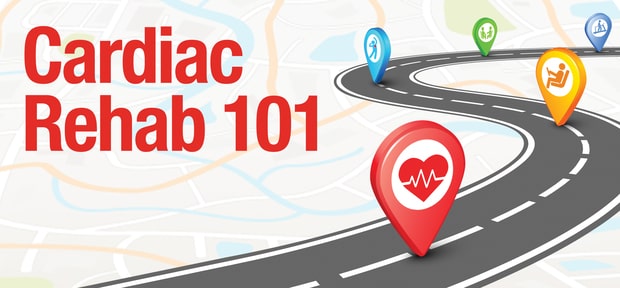Have you ever thought of this wonder you are carrying inside your chest?
This organ that is only the size of a clenched-fist, but is responsible for something as big as keeping you – and every single cell in your body – alive.
The heart is considered one of the miraculous organs in the human body.
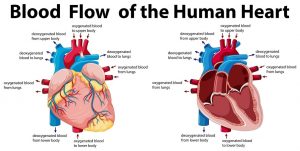
Not only because it is small – yet powerful, but also because it has several unique characteristics that no other muscle has.
When one of these characteristics is lost or interrupted, heart diseases take place.
Would you like to understand more about heart disease?
- Wondering what to eat for a balanced healthy heart diet?
- Looking for effective cardiac rehab for heart failure?
If your answer is yes, it might help you to firstly learn more about how your heart functions.

The Heart Wants What It Wants
Almost everyone is looking for a cardiac rehab for heart failure prevention.
How about understanding how the heart works Before progressing to how it fails?
As a matter of fact, all your skeletal muscles are under your nervous system’s control.
Which means they must receive an order from your central nervous system to start contracting,
This is different when it comes to the heart; the heart literally wants what it wants!
To understand how a Cardiac Rehabilitation Program helps improving your heart health, you need to understand that there are automatic cells in your heart that act as a natural pacemaker.
They initiate electrical impulses to depolarise (stimulate) cells and make them contract without intervention from your brain or spinal cord.
These specialised cells are found in:
- Sinoatrial node (SA node)
- Atrio-ventricular node (AV node)
- Purkinje fibers
Each of these three parts can fire at a specific rate and they are responsible for the automaticity and rhythmicity of your heart.
Usually, the SA node is the maestro that takes lead of generating impulses.
It has the highest firing rate.
Which is 60-100 beats per minute for an average adult. [1]
Does this mean your heart cannot beat faster?
Your heart can beat faster when it is triggered by your autonomic nervous system, for example, when you are exercising in a cardiac rehab program.
The rate and rhythm of your heart are also affected by other factors such as the quality of your fats and more important the electrolytes you consume in your healthy heart diet.
Out of Rhythm? Rehab Is There for You
Normally, when the heart beats under control of the SA node, it is called normal sinus rhythm.
Your cardiologist can easily see this rhythm on ECG by looking at how your ECG waves look like.
Sometimes, your heart can be rhythmic (beating in proper sequence) but can be too fast (Tachycardia) or too slow (Bradycardia).
This may be:
- Sinus tachycardia: normal increase in your heart rate (more than 100 bpm) in response to fear, excitement or stress. And it returns to normal as soon as the stimulus is gone.
- Ventricular tachycardia: occurs when the lower chambers of your heart (ventricles) are stimulated by abnormal signals that starts at the lower part of your heart leading to abnormal heart rhythm.
- Supra-ventricular tachycardia: Similar to ventricular tachycardia. However, the abnormal signal originates in the upper part of the heart.
- Bradycardia: or slow heart rate means your heart completes less than 60 beats per minute. [1], [2]
Expert note:
Slow heart rate can be normal in people who are physically active or athletics.
Because their heart becomes stronger, so it gets to beat less and still deliver sufficient blood to the body!
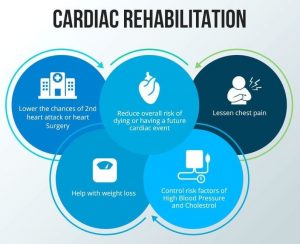
Customised cardiac rehab can make your heart as strong!
Lower your resting heart rate by following a tailored training plan that focuses on improving your cardiovascular capacity!
Contact Jazz Alessi now and find out what works the best for you.
REQUEST a FREE CONSULTATION NOW!
So…
- Have you ever felt your heart is skipping beats?
- Or beating out of rhythm?
- What happens when the rhythm is interrupted?
When the signal is initiated somewhere other than your SA node, your heart beats out of rhythm.
It is called arrhythmia or dysrhythmia.
Arrhythmia comes in many types and forms, and it ranges from trivial to life-threatening. Some examples of arrhythmias are:
- Atrial fibrillation
- Atrial flutter
- Ventricular fibrillation
- Premature ventricular contractions [1], [2]
Can Cardiac Rehab in London help?
Depending on the type of the arrhythmia, cardiac rehab can help you improve your symptoms and prevent unwanted complications.
In fact, it is evident that a customised cardiac rehabilitation plan including is a safe and effective intervention for patients with paroxysmal and persistent atrial fibrillation. [4]
Such a well-designed cardiac rehab programme can help:
- Decrease the resting ventricular response rate in arrhythmia, which means less beats out of the rhythm.
- Improve symptoms linked to arrhythmia (e.g., palpitations, dizziness and fatigue).
- Reduce arrhythmia time.
- Limit the occurrence of serious undesirable outcomes.
- Reduce risk of mortality and hospitalisation [4]
Is cardiac rehab recommended with a pacemaker?
No matter whether you are being treated conservatively or you have a pacemaker implanted.
Cardiac rehab can still help you improve your quality of life as long as it’s customised for your own condition.
REQUEST A FREE CONSULTATION with Jazz Alessi to see how cardiac rehab can be customised to fit your very personal needs.
It’s Electric!
When the signal is initiated by the specialised automatic cells within your heart, it is transmitted to the myocytes (heart cells) in an organised manner that helps the heart beat nice and smooth.
First, the signal flows to the atrial cells (i.e., cells of the upper two chambers) so those muscle cells depolarise and contract while the ventricles (i.e., lower two chambers) are relaxing as they are being filled by blood.
Then, after complete ventricular filling, the ventricular cells receive signals by which they depolarise leading to a powerful contraction of both ventricles.
This is exactly when the blood is pumped out of the heart to your body.
This organised process is regulated in this way because the heart cells are connected to one another by a very impressive conductive system. [1], [2]
Think of it as wires with different conduction velocities, thicker and thinner diameters, delay stations and different voltages!
So, what happens when these wires go wrong?
Sometimes, the conductive system of the heart might get impaired.
For example, after a heart attack, some conductive cells become ischemic (oxygen deprived) and necrotic (dead).
In this case, these cells are no longer able to transmit the signals the way they used to do. [3],[2],[1]
Similar problems are generally referred to as conduction disorders.
What are the most common conduction disorders of the heart?
- Bundle branch block:
Usually, the electrical signal is transmitted to the ventricles through right and left bundle branches at a specific speed allowing both ventricles to contract together as one unit.
When one of the branches is blocked, the signal takes a different path leading to a ventricle contracting slower than the other.
Although the difference is usually a fraction of a second, it still results in irregular heartbeats. [3],[2],[1]
- Heart block:
When you have heart block (also known as AV block), the electrical signal from your heart’s upper chamber slows down or gets interrupted on its way down to the lower chambers.
What is the reason behind a heart block? This can be any of the following:
- Age-related degeneration
- Coronary artery disease
- Specific medications (e.g., beta blockers or calcium channels blockers)
- Some Autoimmune diseases and infections (e.g., rheumatic fever)
- Birth defects
- Electrolyte imbalance (e.g., hyperkalemia – i.e., excessive potassium)
- Heart surgery [1]
How can I tell if my heart is blocked?
Although the name sounds scary, some people with AV block may have no symptoms at all. Some others might experience occasional:
- Light headedness
- Fatigue
- Sense of a skipped beat or palpitations
- Syncope (fainting) [1]
So, what are the treatment options?
If you have a heart block, your cardiologist will help you decide the best treatment option for you depending on your case.
Treatment options can be anywhere from cardiac rehab to artificial pacemakers.
It all depends on the nature and severity of the block; which may be:
- First-degree block: Usually asymptomatic and requires no treatment.
However, it needs to be followed up to prevent it from turning into a higher degree block.
- Second-degree block: may cause symptoms and it is well-responsive to cardiac rehabilitation.
- Complete heart block (third-degree): may require implantation of a permanent pacemaker. [3],[2],[1]
Usually, subjects with first -and sometimes – second-degree blocks are perfect candidates for cardiac rehab alone.

Can you exercise with bundle block?
Bundle branch block – just like other types of arrhythmia – can be accompanied by unpleasant events such as:
- Fainting,
- Lightheadedness or dizziness
- Shortness of breath
- A slow heart rate.
- Palpitation and discomfort
- Nausea
Will exercise worsen my symptoms?
Symptoms are probably the reason why you shy away from exercising.
However, exercising under cardiologist and personal trainer supervision can actually improve your heart health as long as you respect your heart’s limits and exercise within your safe-zone.
It is recommended to have a regular exercise routine that is individually tailored for your case.
This will help you improve your heart health and avoid exacerbating your symptoms.
Your exercise routine might include:
- Short-duration, low intensity exercises
- Limiting your heart rate below a specific number
- Supervised gradual increase in the intensity while avoiding strenuous exercises.
- Warming up, cooling down and steady state cardio (e.g., walking, cycling, rowing).
- 121 Pilates
- Stretching and yoga exercises.
Not Only Exercise, But Also Diet
If you have a problem with your heart’s rhythm, it might also be due to a defect in your diet. [5]
Some transient types of arrhythmia might be caused by excessive caffeine intake [3] or by an electrolyte imbalance [5].
Because the electricity is initiated and transmitted through cells and from a cell to another depending on electrolytes like:
- Potassium
- Calcium
- Sodium
- Magnesium [5]
Abnormal increase or decrease of these electrolytes might affect your heart rhythm.
For example, low intake of potassium can lead to hypokalemia which results in:
- A Decrease in conduction velocity.
- Increased automaticity.
- Shortening of the effective refractory period.
This period refers to the time during which the cells are not responding to a new stimulus; allowing the previous cycle to be completed in full.
If the refractory period is too short, a new contraction may take place before completing the previous one. Leading to abnormal rhythm. [5]
So, something as simple as diet modification can help you get your rhythm back.
If you are looking for a customised nutrition diet programme and exercise plan to improve your heart rhythm, consult Jazz Alessi’s team of cardiologists, he is an expert cardiac rehab and nutrition specialist.
REQUEST A FREE CONSULTATION NOW!

The Heart as a Machine
The heart does not only function as an electrical device.
There are also mechanical elements that are necessary for it to function properly.
To learn more about this fact, you need to know about the following:
Valve Diseases
As you may know, the heart is divided into four chambers, the atria (upper chambers) are separated from the ventricles (lower chambers) by valves that open to allow filling and close to allow effective pumping.
Those valves are called the atrio-ventricular valves. And they are:
- The Mitral Valve: separating left atrium and the left ventricle
- The Tricuspid Valve: Separating right atrium and the right ventricle
There are also two valves between ventricles and the large vessels connected to them. Those are:
- The Aortic Valve: between the left ventricle and the aorta
- The Pulmonary Valve: between the right ventricle and the Pulmonary artery. [1], [2]
Sometimes, valves become too loose (valve prolapse) or too tight (Valve stenosis).
These two problems may not cause any symptoms, or they can be associated with symptoms like:
- Chest tightness
- Palpitations
- Shortness of breath
- Light-headedness
- Fatigue
What is it’s left untreated?
Untreated valvular diseases can put extra load on your heart and lead to serious complications.
This is why it is important to consult your cardiologist who will recommend you:
- Take medications or
- Undergo valve replacement or repair and
- Get enrolled in a cardiac rehab programme [6], [7]
Pumping failure
Ventricles are the two lower chambers of your heart.
They are responsible for pumping the blood against the resistance originating from the high pressure in arteries.
- The left ventricle: pumps oxygen-rich blood through the aorta to nourish body organs and cells.
- The right ventricle: pumps de-oxygenated blood to the lungs through the pulmonary artery where it brings oxygen and gets rid of carbon dioxide. [1], [2]
In some heart diseases, the heart becomes unable to pump sufficient blood to the rest of the body.
This is called heart failure.
Heart failure is usually the final and most severe manifestation of nearly every heart disease, including:
- Coronary artery disease (CAD)
- Atherosclerosis,
- Myocardial infarction,
Valvular diseases, - Hypertension,
- Congenital heart disease and
- Cardiomyopathies (Diseases of the heart muscle leading to inability of the heart to pump blood properly)
- Age-related degeneration [1,2,8]
Although numbers of people diagnosed with heart failure are on the rise, it is thought to be due to today’s increase in treatment options for different heart diseases.
The good news is: Early cardiac rehab can prevent or delay chronic heart failure and can also improve cardiac function in cases of chronic heart failure [11]
All you need to do is to get the right:
- Nutrition Diet plan customised for your specific needs
- Exercise training programme
- Lifestyle modifications
- Medication plan [9,10,11]
Heart failure will never hold you back from exercising.
Speak to Jazz Alessi, or any reputable expert cardiac rehab specialist and find out how you can make your heart stronger!
REQUEST A FREE CONSULTATION NOW!
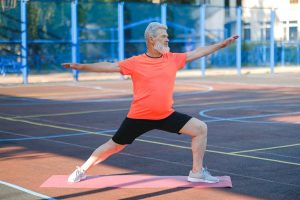
Ageing and The Heart
Aging affects our bodies in different ways.
This is the reason why we look and feel different when we grow older.
Changes associated with aging occur at two levels:
- Micro-Cellular: changes that occur in cells themselves including their shape, composition and lifespan.
- Macro-cellular: changes that occur in organs including changes in their structure and function.
Broadly speaking, all systems undergo age-related alterations.
And the cardiovascular system is not an exception.
As we grow older, our heart also grows older.
Here are some of the cardiac changes that take place:
- Altered ventricular systolic and diastolic functions (filling and pumping)
- Diminished cardiac reserve
- Cardiac hypertrophy (increased size of the heart)
- Increased arterial stiffness
- Impaired endothelial (inner vessel) function [8]
Due to these alterations, there is an increase in incidence and prevalence of:
- Atherosclerosis,
- Hypertension,
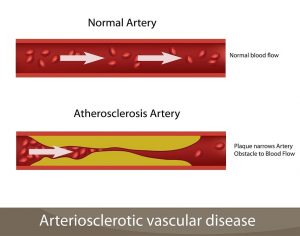
- Coronary artery disease
- Heart failure
- Cerebrovascular and
- Peripheral vascular disease. [8]
Although age-related changes are physiological changes that take place, they are preventable by the following measures:
- Diet modifications
- Lifestyle modifications including getting rid of poor habits (e.g. smoking)
- Regular exercising in a custom manner
- Weight loss – make it sustainable
- Risk factor modification (e.g., controlling diabetes, hypertension, high lipid profile… etc.)
- Regular check-ups and early detection of any cardiovascular diseases [9,10]
Exercising is a Must
Did you know low intensity cardio training is one of the best exercise for heart health?
I know exercising with an already present heart disease might feel frightening at first glance.
But, an exercise-based cardiac rehabilitation programme is necessary.
It helps you reverse the effects of heart disease on your physical fitness and limits occurrence and recurrence of angina attack symptoms.
According to studies, a proper personalised rehab programme along with a customised heart healthy diet plan can lead to significant improvements in:
- Exercise tolerance,
- Walking capacity,
- Muscle strength and
- Quality of life. [9,10]
- Confidence levels
- Positive life outlook

What’s in it for Your Heart?
It was evident that customised exercises help your heart function in a better way, reduces angina attack symptoms and prevents disease progression.
In other words, low intensity exercises involving large muscle groups lead to:
- Increased ejection fraction of the heart
This is the amount of blood your ventricle can pump in one squeeze
- Decreased resting heart rate
Because it makes your heart stronger. So, it doesn’t need to beat fast.
- Decreased load on the heart
Due to reduction of the peripheral arterial pressure.
- Improved perfusion and oxygenation to the heart muscle
By dilating the coronary vessels and keeping them flexible and also by opening new collateral vessels to supply the heart with oxygen.
If you need to talk to a professional who understands your concerns and values your health goals, speak to Jazz Alessi, or any elite cardiac rehab specialist who can help you set an outline for your rehabilitation period.
Request a FREE CONSULTATION NOW!
Cardiac Rehab, Is It for Every One?
Due to the very high risks involved there is no one – fits-all programme for cardiac rehabilitation.
Because heart diseases are of different pathologies, they require different safe (and safe is a key word here) rehabilitation plans.
In other words, if the plan is not right for you, it will put you at risk or it might not be effective.
And – even worse – it might be harmful for your condition!
- For this reason, never trust a cardiac rehab programme shared online or recommended by a friend as the best exercise for heart health.
- Because each programme is right only for whom it was designed.
In general, Cardiac rehab programmes are composed of:
- Medical treatment
- Cardiac diet plan
- Exercise training programme
- Lifestyle modifications
- Risk control
- Psychological support
- Occupational support [8],[9]
As a part of a comprehensive cardiac rehab plan, exercising will give you the following benefits:
- Improve your heart-health
- Reduce frailty,
- Reduce risk of complications and comorbidities.
- Reduce your blood pressure
- Reduce Stress and anxiety
- Improve self-confidence [7],[6], [8],[9]
Does Rehab Make Difference?
Following a long-term rehabilitation plan including medical treatment, exercise and cardiac diet plan seems like too much commitment at the first glance.
However, it is worth it because it can completely change your life after a cardiac event.
According to statistics, cardiac rehab is associated with about 50% lower mortality rate. [12]
In other words, it helps you live longer.
Recent studies have found that cardiac rehabilitation decreases the chance that you will die in the 5 years following a heart attack or bypass surgery by about 35%. [13]
In addition, cardiac rehab is closely related to a significant increase in quality of life.
It is evident that participants who took part in a comprehensive cardiac rehab programme had:
- Increase in exercise tolerance
- Increased physical activity compared to non-participants
- Increased level of independence
- Ability to go back to work in phase 3 or 4 of cardiac rehab depending on the nature of the work
- More adherence to medications and to heart healthy diet plan
- Life-long modifications of habits and lifestyle
- Decreased depression and anxiety [12,13,14]
Wondering about the best cardiac rehabilitation programme for your case?
Have a personalised consultation with Jazz Alessi, or any expert cardiac rehab specialist.
Request a FREE CONSULTATION NOW!
Who is Jazz Alessi?
Jazz Alessi is an elite personal trainer in London working closely as a team with your cardiac rehab specialist.
He is a long term-Harley Street expert nutritionist who is passionate and customise the perfect nutrition diet plan and Cardiac rehab programme exercise plan that matches your very personal needs.
Jazz works closely with expert cardiologists, researchers, university professors and other health professionals to help you achieve the optimum heart health safely, and in no time and alongside your cardiologist provides evidence based cardiac rehab programmes in London (and online).
REFERENCES
1. Leonard S. Lilly, MD (2011) : Pathophysiology of Heart Disease – A Collaborative Project of Medical Students and Faculty – FIFTH EDITION
Pathophysiology of Heart Disease: A Collaborative Project of Medical Students and Faculty, 6e | Medical Education | Health Library (lwwhealthlibrary.com)
2. Anatomy And Physiology of The Cardiovascular System – Chapter 5
samples.jbpub.com/9781449652609/99069_ch05_6101.pdf
3. Cardiac Arrhythmias: Mechanisms of Arrhythmias, Atrial, Ventricular, Conduction and ST Changes. (2011) Canterbury district health board – Cardiology
Module 3 – Cardiac Arrhythmias-Mechanisms of Arrhythmias.pdf (cdhb.health.nz)
4. Robaye B, Lakiss N, Dumont F, Laruelle C. Atrial fibrillation and cardiac rehabilitation: an overview. Acta Cardiol. 2020 Apr;75(2):116-120. doi: 10.1080/00015385.2019.1565663. Epub 2019 Feb 22. PMID: 30794758.
Atrial fibrillation and cardiac rehabilitation: an overview – PubMed (nih.gov)
5. Nabil El-Sherif, Gioia Turitto (2011): Electrolyte disorders and arrhythmogenesis, Cardiology Journal2011, Vol. 18, No. 3, pp. 233–245
(PDF) Electrolyte disorders and arrhythmogenesis | Gioia Turitto – Academia.edu
6. Nechwatal RM. Cardiac rehabilitation after surgical and transcatheter valve replacement and repair. Dtsch Z Sportmed. 2018; 69: 285-292.
Review_Nechwatal_Rehabilitation_of_Valvular_Patients_2018-9.pdf (germanjournalsportsmedicine.com)
7. Renu B.Pattanshetty et.al.. EFFECTIVENESS OF LOW INTENSITY EXERCISES ON SIX MINUTE WALK DISTANCE AND HAEMODYNAMIC VARIABLES IN CABG AND VALVE REPLACEMENT PATIENTS DURING PHASE 1 CARDIAC REHABILITATION IN A TERTIARY CARE SETUP: A COMPARATIVE STUDY.
287-1413000307.pdf (oaji.net)
8. Nikhra, Vinod. (2017). Aging Heart: Recent Research and Concepts. Gerontology & Geriatrics Studies. Volume-1. 1-11. 10.31031/GGS.2017.01.000501.
(PDF) Aging Heart: Recent Research and Concepts (researchgate.net)
9. Dalal, Hasnain & Doherty, Patrick & Taylor, Rod. (2015). Cardiac rehabilitation. BMJ. 351. 10.1136/bmj.h5000.
(PDF) Cardiac rehabilitation (researchgate.net)
10. Lear, Scott & Ignaszewski, Andrew. (2001). Cardiac rehabilitation: A comprehensive review. Current controlled trials in cardiovascular medicine. 2. 221-232. 10.1186/cvm-2-5-221.
(PDF) Cardiac rehabilitation: A comprehensive review (researchgate.net)
11. Flynn KE, Piña IL, Whellan DJ, et al. Effects of Exercise Training on Health Status in Patients With Chronic Heart Failure: HF-ACTION Randomized Controlled Trial. JAMA. 2009;301(14):1451–1459. doi:10.1001/jama.2009.457
Effects of Exercise Training on Health Status in Patients With Chronic Heart Failure: HF-ACTION Randomized Controlled Trial | Cardiology | JAMA | JAMA Network
12. Kashish Goel, Ryan J. Lennon, R. Thomas Tilbury, Ray W. Squires, and Randal J. Thomas: Impact of Cardiac Rehabilitation on Mortality and Cardiovascular Events After Percutaneous Coronary Intervention in the Community
Impact of Cardiac Rehabilitation on Mortality and Cardiovascular Events After Percutaneous Coronary Intervention in the Community | Circulation (ahajournals.org)
13. Servey JT, Stephens M. Cardiac Rehabilitation: Improving Function and Reducing Risk. Am Fam Physician. 2016 Jul 1;94(1):37-43. PMID: 27386722.
Cardiac Rehabilitation: Improving Function and Reducing Risk – PubMed (nih.gov)
14. Yohannes, Abebaw & Doherty, Patrick & Bundy, Christine & Yalfani, Ali. (2010). The long-term benefits of cardiac rehabilitation on depression, anxiety, physical activity and quality of life. Journal of clinical nursing. 19. 2806-13. 10.1111/j.1365-2702.2010.03313.x.
(1) (PDF) Impact of Cardiac Rehabilitation on Functional Capacity and Physical Activity after Coronary Revascularization: A Scientific Review (researchgate.net)



